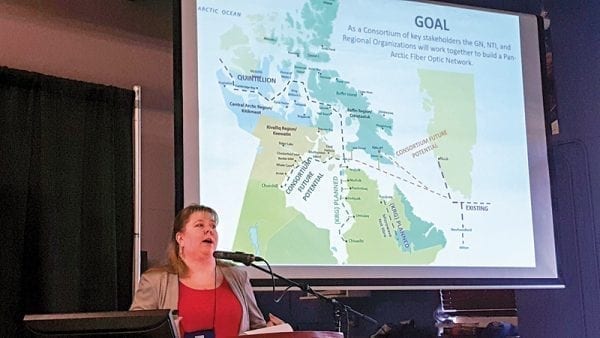The internet will soon be a lot faster. By the end of 2019, Nunavut residents in each community will have access to internet speeds to a maximum of 15 megabits per second (Mbps), up from the current 5 Mbps, higher usage caps, up to 100 gigabytes of monthly data usage, and prices between 30 to 60 per cent lower as a new network rolls out.

That's thanks to a $50 million federal investment into a Northwestel-built backbone, announced in Iqaluit Sept. 14. The company, a direct subsidiary of Bell Canada, will invest $73 million.
A backbone is the main network that carries all the information at high speeds, which in Nunavut is satellite-based rather than through fibre-optic cable.
"The funding is for a next-generation backbone for this territory," said Northwestel's Curtis Shaw at a Nunavut Trade Show presentation.
"I'm really proud to say that Nunavut is getting 10 per cent of that (Connect to Innovate) funding. We have about one per cent of the population and we took 10 per cent of the funding, which is phenomenal."
Northwestel currently only services four Nunavut communities, but by the end of 2019 it will offer services in the remaining 21. Bell Mobility will also offer 4G cell phone service in each community.
Shaw was part of a panel of speakers that included Dean Proctor of Qiniq/SSi Micro, Elaine Robichaud of Telesat Canada, Tina Pidgeon of Alaska's General Communication Inc. (GCI), deputy minister of the GN's Community and Government Services Lori Kimball and director of Nunavut Tunngavik Inc.'s policy and planning division Hannah Uniuqsaraq.
SSi's Proctor told Nunavut News/North that it's great news that backbone technology is being funded, as previously investments were only directed to "last mile" technology – which is the technology that gets internet to individual homes and offices.
Currently, Nunavut's backbone is being fed by Telesat Canada satellites Anik F2 and Anik F3. Qiniq, which already offers service to the territory's 25 communities, has been adding 4G-LTE capabilities. This was possible via $35 million from another federal program called Connecting Canadians, which SSi received in late 2015. SSi invested $75 million.
"The new network will have about 20 times the bandwidth we have for Nunavut today," said Shaw, adding the Government of Nunavut would have 5000 megs of broadband for its schools and health centres.
"That will change education in the territory. It will change the way teachers use technology, it will change all the things students can do with video, collaboration and distance education."
However, SSI's Proctor warned that long-term planning with long-term funding, rather than the patchwork funding model currently in place, is required.
"Let's make no mistake, despite all the investments going on, that Northwestel is carrying on, that Telesat is doing and we're doing, five years from now it's going to feel even worse again. It's not a lack of technical ability, it's a lack of funding. Lack of capital to build infrastructure."
As Telesat's Elaine Robichaud explained, the company is scheduled to launch two new Ka-band high-throughput satellites (HTS) next year. That's the technology Northwestel will hook up with, and it will be open access so all service providers can use the capacity.
Inuit need to be full contributors and partners
But beyond that, in 2021, Telesat plans to launch the LEO (low earth orbit) constellation, which is currently in development. LEO is a planned global grid of more than 200 satellites that will offer constant, 100 per cent coverage throughout the world. Called "fibre in the sky," LEO constellations are projected to offer high-speed internet equivalent to terrestrial fibre-optic networks.
Unlike the south, to service Nunavut, much of a fibre network would need to be undersea, where repair is only possible in ice-free conditions and only after deploying a specialized ship and crew from the south, as noted by SSi.
But that's the future, and the present is different, as NTI's Uniuqsaraq noted.
"The power of connectivity or lack thereof is entrenched in every facet of our lives and the development of our territory. It's both accelerating and impeding socio-economic development within our territory. It requires focused attention," she said, adding Inuit political organizations across Inuit Nunangat, along with regional development corporations, are exploring synergies to better understand the challenges and opportunities.
Uniuqsaraq said improved connectivity and broadband services dominated the Circumpolar Inuit Economic Summit earlier this year.
"We know all too well the vulnerability we face with our infrastructure, and particularly broadband," she said.
Inuit development corporations from all four Canadian regions, as well as Inuit Tapiriit Kanatami and Inuit Circumpolar Council, are exploring potential models and discussing how to influence policies and programs to position Inuit as full contributors and partners, and to connect Nunavut to the east, west and south, said Uniuqsaraq.
"We're looking at ways to leverage our influence with governments and others for long-term investments rather than two to five year program increments that just keep our heads above water."